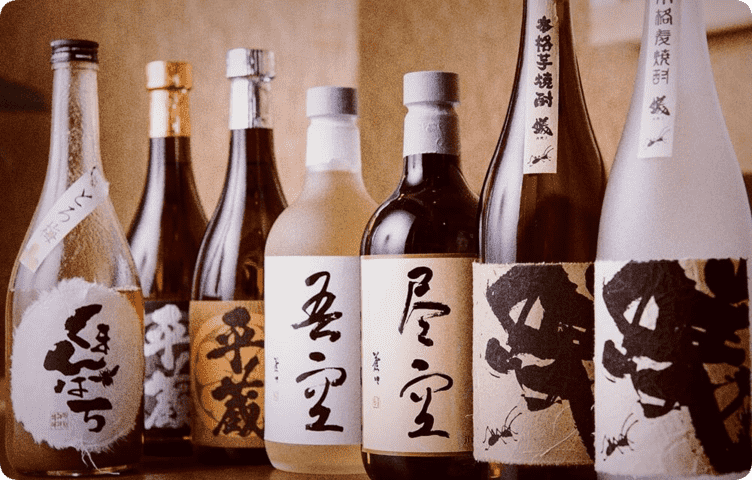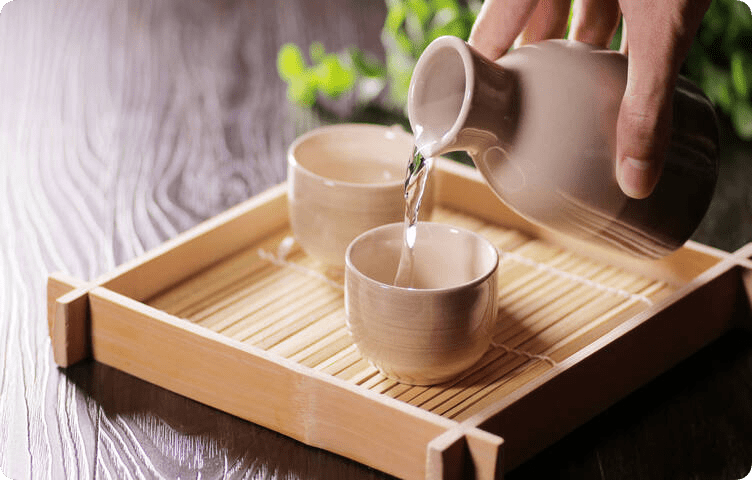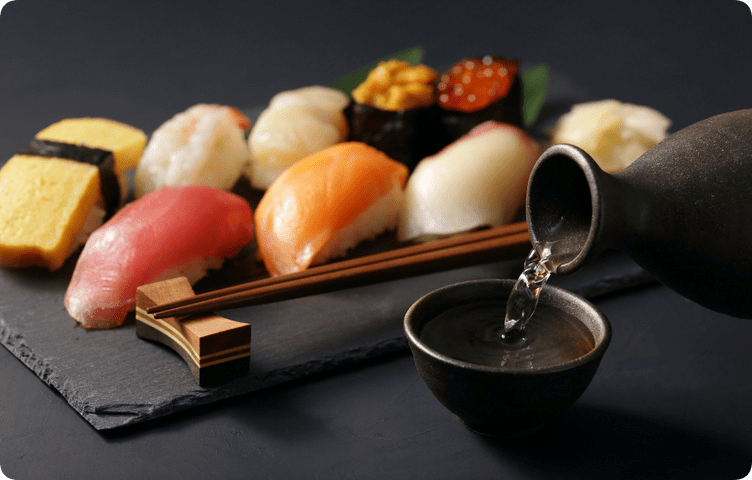Exquisite Japanese cuisine has won the hearts of gourmets around the world. Along with savory sushi and tempura, we learned about sake, a traditional grain alcohol that holds an important place in Japanese culture. Not everyone is able to appreciate it on the first try. To understand its unusual taste profile, you need to get acquainted with the characteristics of the drink and learn the rules for its use.
Sake varieties
The official name of Japanese alcohol is Nihonshu. It is prepared from special rice, the grains of which are polished and then fermented with the help of special fungi and yeasts. The resulting liquid contains more alcohol than the strongest wine - from 18 to 20%. The variety of rice is called sake, and this term gradually evolved into a designation for the drink.

There are five types of it, which differ in production technology and taste properties:
Junmai-shu – does not contain alcohol, starch or sugar. The basis is a preparation consisting of 70% crushed unpolished rice. The drink has a rich taste, with a higher acidity level compared to other varieties. The aroma is weak. Junmai shu is often reheated before serving.
Ginjo-shu is made from rice, 40% of which is milled, and the remaining amount is not polished. During fermentation, the rice puree is cooled using a special type of yeast. Thanks to this, alcohol acquires a bright aroma and delicate taste. To preserve these properties, the drink is served cold.
Daiginjo-shu is a type of ginjo-shu, which is also prepared based on a rice preparation. It contains from 35 to 50% unpolished grains. The alcohol has a pronounced aroma, mild taste and a short aftertaste.
honjozo-shu - created from a base consisting of 70% uncrushed grains. The recipe uses beer alcohol, which gives the drink a light consistency and pleasant aroma. The strength of honjozo-shu is less than that of other varieties. It is usually served warm.
namazake - this category includes all types of rice alcohol that have not been pasteurized. It must be stored in the refrigerator to preserve the taste and aroma.
There is also an unfiltered version called nigori-zake. It is slightly cloudy, has a sweet taste, and is used as a dessert wine.
Sake production technology
Like wine and beer, Japanese traditional alcohol is made through fermentation. But the preparation method is much more complicated - the process of converting starch into sugar occurs simultaneously with the conversion of sugar into alcohol. This method is called multiple parallel fermentation, and is not found in any other alcoholic beverage.
The production cycle takes two months. It consists of seven stages:
- grinding and grinding rice;
- soaking grains, steaming;
- adding koji fungus spores;
- mixing with water and yeast starter (syub);
- fermentation;
- cleaning using a filter machine or mesh;
- settling and repeated filtration.
If the finished product is too strong, it is diluted with water. Often the drink is pasteurized and, in order to preserve the taste and smell, left to “ripen” for 6-12 months.
How to pour

According to Japanese etiquette, sake is brought to the table in a tokkuri, a traditional round jug with a thin neck. If you don't have such a product at home, use a similar shaped vessel or pour directly from the bottle. It is important to hold the utensils correctly, with both hands, as the Japanese do.
When pouring, hold the tokkuri with your right hand close to the neck and place your left hand on the bottom of the jug. It is not customary to pour yourself a drink. Even in an informal setting, interlocutors fill each other's glasses. Usually these are “ochoco” - ceramic cups without a stem. They are also held with both hands, the ochoko is taken with the right, and the bottom of the cup is touched with the left.
The glass is lifted from the table when the interlocutor fills it for you. Immediately after pouring, take at least one sip before placing the ochoco on the table. Do not fill cups to the top. The alcohol is quite strong, so you should drink in small portions.
Ways to drink sake
To truly enjoy the drink, you need to take it according to the rules accepted in Japanese culture. Drinking this alcohol has long been considered a ritual of friendly respect. The main methods of administration are related to temperature:
okan – heating. Suitable for inexpensive varieties that do not have an exquisite taste profileIlya. As the temperature rises, the fruit notes soften and the acidity is muted. However, sake should not be hot; it is usually heated to 40-50 degrees;
reishu – cooling. Low temperature also masks some nuances and allows you to more vividly experience the taste of a premium drink;
hiya – supply at room temperature. The method preserves the taste characteristics without changes. Expensive varieties are often served in such a way as to prevent the appearance of off-flavors.
But every sake lover chooses his own drinking option. Since stores sell inexpensive varieties that don't have a specific flavor profile, try different serving temperatures to see what your preferences are.
Toasts
The Japanese do not start drinking without the traditional short speech with good wishes to the interlocutors. The most common toast is “Kanpai!”, which is similar to the Russian phrase: “Drink to the dregs!” As you say these words, gently touch the cups to the people at the table.
You should not drink the entire portion in one gulp, like vodka. Etiquette rules recommend drinking the drink gradually, in small sips.
A more sophisticated version of the toast is “Otsukare-sama desu,” which translates to “Thank you for your hard work.” This phase is suitable for friendly gatherings in the evening, after work.
If there are people at the table with you who are senior in age or position, you should wait until one of them makes a toast. While listening to the phrase, hold the glass with one hand and touch the bottom with the other. At business lunches, toasts that are acceptable are “Otsukare-sama desu” or “Eroshiku-onegai shimasu,” which means “Nice to meet you.”
How to drink sake at home
A versatile Japanese drink that easily adapts to different situations. Its use is a kind of ritual intended for friendly communication. If you're planning a small house party, place small cups and a small decanter, preferably heat-resistant, on the table. Don't use sake as a substitute for a cocktail. It should be treated more like a fine wine that accompanies a gourmet meal.
Be sure to serve Asian spirits with appetizers. The weakly expressed flavor profile allows you to create combinations with a large number of products - meat, fish, vegetables, desserts.
What's good for a snack?

In the Land of the Rising Sun, sake occupies a secondary place in relation to food. Even expensive varieties are served only to highlight the taste of the dishes. The most successful combinations are considered to be with traditional Asian dishes - sushi, sashimi, ramen.
The refreshing taste of sake harmonizes well with snacks from different countries. The selection depends on the type of drink:
ginjo-shu - distinguished by fruity notes that will highlight the taste of fried fish, baked poultry, and grilled meat;
Namazake has a bright, fresh taste. It can be served with any dish, including fried chicken, pizza, caviar tartlets;
Junmai-shu - served warm, so suitable as an aperitif. Pairs with hearty foods, including cheese, kebabs, and grilled sausages.
Unfiltered varieties are sweeter, so they are used as an addition to desserts, cheeses and fruits.
How to store sake
The most convenient storage option is a cool, dark place, such as a refrigerator. In this form, the properties of alcohol are preserved for up to 16 months. An unfinished bottle can also be placed in the refrigerator, after closing the neck with a cork. It is recommended to drink it within one to two weeks after opening.
Sake producers usually indicate the bottling date on the label. Experts advise drinking the drink soon after this period.
















































/https%3A%2F%2Fcomplexbar.com%2Fimages%2Fblog%2F133%2Fsake.jpg)
/https%3A%2F%2Fcomplexbar.com%2Fimages%2Fblog%2F246%2Fsirop_scale_2400.jpeg)
/https%3A%2F%2Fcomplexbar.com%2Fimages%2Fblog%2F246%2Fkofe-vostochniy.jpg)
/https%3A%2F%2Fcomplexbar.com%2Fimages%2Fblog%2F245%2Fpexels-jason-villanueva-851555.jpg)
/https%3A%2F%2Fcomplexbar.com%2Fimages%2Fblog%2F246%2F2024-04-09_17.22.54.jpg)
/https%3A%2F%2Fcomplexbar.com%2Fimages%2Fblog%2F246%2F2024-04-09_17.22.47.jpg)
/https%3A%2F%2Fcomplexbar.com%2Fimages%2Fblog%2F246%2FCODE_anons_foamydrops_752%D1%85480_eng.jpg)
/https%3A%2F%2Fcomplexbar.com%2Fimages%2Fblog%2F246%2FAlina_752%D1%85480_eng.jpg)
/https%3A%2F%2Fcomplexbar.com%2Fimages%2Fblog%2F246%2F2024-04-09_17.23.22.jpg)
/https%3A%2F%2Fcomplexbar.com%2Fimages%2Fblog%2F246%2F2024-04-09_17.23.28.jpg)
/https%3A%2F%2Fcomplexbar.com%2Fimages%2Fblog%2F246%2F2024-04-09_17.23.35.jpg)
/https%3A%2F%2Fcomplexbar.com%2Fimages%2Fblog%2F246%2Fdrinksome_752%D1%85480_eng.jpg)
/https%3A%2F%2Fcomplexbar.com%2Fimages%2Fblog%2F246%2Fnude_752%D1%85480_eng.jpg)
/https%3A%2F%2Fcomplexbar.com%2Fimages%2Fblog%2F246%2F752%D1%85480_eng__1_.jpg)
/https%3A%2F%2Fcomplexbar.com%2Fimages%2Fblog%2F246%2F752%D1%85480_eng.jpg)
/https%3A%2F%2Fcomplexbar.com%2Fimages%2Fblog%2F246%2FStudioRaw_752%D1%85480_eng.jpg)
/https%3A%2F%2Fcomplexbar.com%2Fimages%2Fblog%2F246%2FDoppio_tea_752%D1%85480_eng.jpg)
/https%3A%2F%2Fcomplexbar.com%2Fimages%2Fblog%2F246%2FTognana_Stars_Stripes_752%D1%85480_eng.jpg)
/https%3A%2F%2Fcomplexbar.com%2Fimages%2Fblog%2F246%2FRona_752%D1%85480_eng.jpg)
/https%3A%2F%2Fcomplexbar.com%2Fimages%2Fblog%2F246%2FDoppio_vending_752%D1%85480_eng.jpg)
/https%3A%2F%2Fcomplexbar.com%2Fimages%2Fblog%2F246%2FEssence_sukhie_smesi_752%D1%85480_eng.jpg)
/https%3A%2F%2Fcomplexbar.com%2Fimages%2Fblog%2F246%2FODK_sukhie_smesi752%D1%85480_eng.jpg)
/https%3A%2F%2Fcomplexbar.com%2Fimages%2Fblog%2F246%2Funiforma-barmena.jpg)
/https%3A%2F%2Fcomplexbar.com%2Fimages%2Fblog%2F246%2Fkak-nanyat-barmena.jpg)
/https%3A%2F%2Fcomplexbar.com%2Fimages%2Fblog%2F246%2Fsirop_scale_2400.jpeg)
/https%3A%2F%2Fcomplexbar.com%2Fimages%2Fblog%2F246%2FPeugeot_Anons_Paris_U%27Select_Line_Daman_752%D1%85480_eng.jpg)
/https%3A%2F%2Fcomplexbar.com%2Fimages%2Fblog%2F246%2Fkofe-vostochniy.jpg)
/https%3A%2F%2Fcomplexbar.com%2Fimages%2Fblog%2F246%2FMadler.jpg)
/https%3A%2F%2Fcomplexbar.com%2Fimages%2Fblog%2F246%2Fprofbartender_glavn.jpeg)